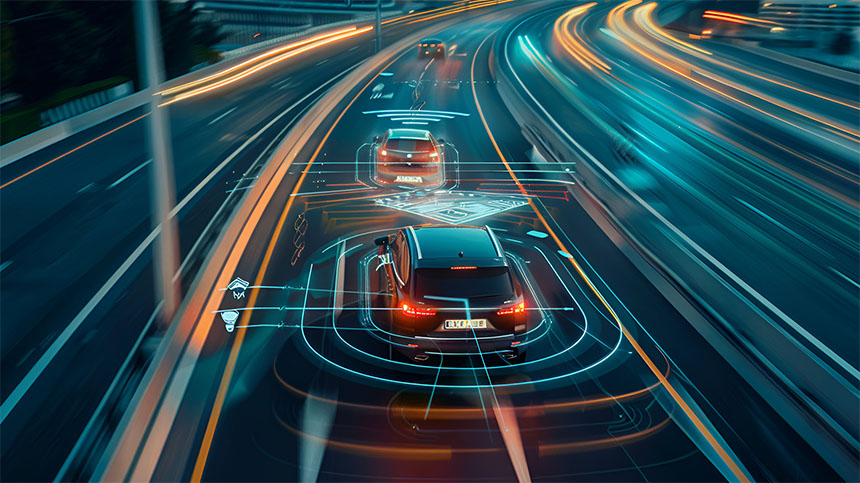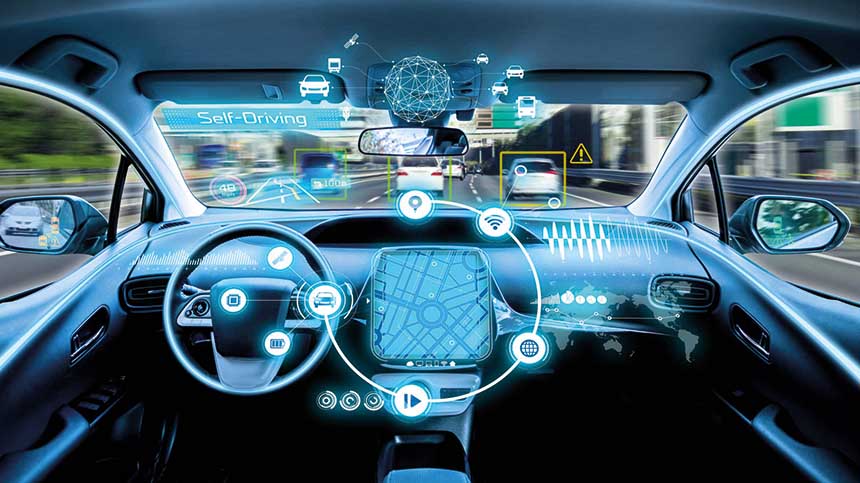Thatcham clarifies new EU vehicle safety regulation

The European Union’s New Vehicle General Safety Regulation (the EU vehicle safety regulation), also known as GSR2 or Regulation (EU) 2019/2144, comes into effect across Europe on Sunday, 7 July 2024.
It amends the minimum performance standards (known as type approval) for motor vehicles in the EU, adding new required advanced driver assistance systems (ADAS). These include Intelligent Speed Assist (ISA), Autonomous Emergency Braking (AEB), Driver Drowsiness and Attention Warning (DDAW), and Emergency Lane Keeping Systems (ELKS).
EU vehicle safety regulation
Yousif Al Ani, principal engineer-ADAS at Thatcham Research, said of the EU vehicle safety regulation:
“Crash avoidance is the future of automotive safety. Modern vehicles are very good at protecting occupants in the event of a collision through passive safety features, such as airbags and crumple zones, but these have limited benefit to vulnerable road users [VRUs].
“KSI [killed or seriously injured] statistics among VRUs remain stubbornly high at more than 11,000 each year. The key to reducing these numbers is through the wider introduction of active crash avoidance systems.

“The UK is yet to sign up to GSR2 which vehicle manufacturers will adhere to across Europe. The technology mandated by this directive is already found in most new cars and the UK could be at risk of falling behind in automotive safety by not adopting it.
“As ADAS is increasingly fitted to cars, vehicle manufacturers will need to address concerns from drivers that these systems, such as Emergency Lane Keeping Systems, interfere with their driving experience. Striking a balance between safety, performance, and integration to create systems that cooperate with drivers is a real challenge for manufacturers.
“Drivers must also be aware that ISA is an assistance system and that they will remain liable for the safety of their vehicles. Incorrect information provided by ISA does not exempt drivers from speed limit infractions. It can also be overridden or switched off at any time.”
What does GSR2 mean for the UK?
Many vehicles sold in the UK will use EU specification software as manufacturers try to avoid the additional complexity of creating UK-specific variants, which increases the cost of bringing a vehicle to market.
Northern Ireland will adopt GSR2 requirements following the EU type approval process due to the Northern Ireland Protocol, which also adds additional variant complexity.
Where there is a difference in regulations within a specific region, manufacturers typically cater to the most complex market, leading to EU specification vehicles likely being sold in the UK.
When does GSR2 apply?
GSR2 first applied from July 2022 in Phase 1, which mandated additional technical requirements on new vehicle models, without adding new features.
Phase 2 applied to new vehicle models from July 2022, but from July 2024 applies to existing vehicle models. This mandates ADAS features such as ISA, AEB, DDAW, and ELKS.
Phase 3 also applies from July 2026, mandating an increase in scope to include Advanced Driver Distraction Warning (ADDW) and additional pedestrian and cyclist AEB.
For new vehicle models which are not type-approved before the deadline:
- Phases 1 and 2 applied in July 2022 .
- Phase 3 will apply from July 2024 .
For existing vehicle models which are already type approved by the deadline:
- Phase 1 applied in July 2022 .
- Phase 2 will apply from July 2024 .
- Phase 3 will apply from July 2026 .
The regulation applies only to vehicles built after the cut-off dates. No retrofit or software changes are required for any vehicles built before Wednesday, 6 July 2022, or existing models built up to Sunday, 7 July 2024.
Intelligent Speed Assist
What is it?
Intelligent Speed Assist (ISA) recognises traffic signs and provides an overspeed warning. This feature is already fitted to many pre-GSR2 vehicles.
It warns the driver when the speed limit is exceeded to increase speed limit compliance and reduce the severity of collisions.
How does it function?
It uses a forward-facing camera mounted in the windscreen to detect traffic signs in conjunction with speed limits from map data.
If the speed limit is exceeded the driver is given visual and audio feedback, typically via a chime and the speed limit flashing within the vehicle instrument cluster.
A few select vehicles implement feedback via the accelerator pedal, but most vehicles only employ audio and visual warnings. ISA can be temporarily overridden by the driver at any time by continuing to apply pressure to the accelerator pedal.
Can you turn it off?
It can be switched off but GSR2 requirements mandate that the feature is re-enabled – automatically switched back on – every time the car is started.
This is the key difference in GSR2-compliant vehicles versus existing vehicles which already possess a form of traffic sign recognition. The other key difference is that the regulation mandates systems achieve an accuracy of greater than 90% in all EU member states, where there are no performance criteria for older systems.
Are there any issues drivers may experience?
Systems may detect the wrong speed limit where signage is missing or inaccurate due to incorrect or outdated maps. It is therefore crucial that drivers install regular map updates provided over-the-air by the vehicle manufacturer.
Temporary signs, such as roadworks, may conflict with valid map data. Drivers may make an appropriate choice of whether ISA is providing a safety benefit and can override the feature by accelerating. Drivers must be reminded that they are always liable for the safe and legal progress of the vehicle.
Will it change in the future?
There are no additional requirements planned for ISA, but as part of the regulation vehicles must capture and store data regarding how the feature is used. The European Commission will continue to monitor and review how ISA works in the real world as it rolls out on to more vehicles.
Other EU vehicle safety regulation mandated technology
Autonomous Emergency Braking (AEB)
AEB is a collision avoidance feature using forward-facing cameras, RADAR and potentially other sensor technologies like LIDAR to prevent collisions.
It scans the forward path of the vehicle for potential impact targets and applies braking to avoid or mitigate a collision. It applies to specific scenarios, such as car-to-car, car-to-pedestrian and car-to-cyclist in different orientations.
AEB has been shown in studies to reduce car-to-car rear end collisions by around 50% and car-to-pedestrian collisions by around 30%. It also provides impact mitigation where a collision cannot be avoided, reducing the severity of injuries. It causes no noticeable impact to drivers, operating in the background with an extremely low false event rate.
GSR2 Phase 2 mandates car-to-car rear and crossing pedestrian collision scenarios to be supported by every new vehicle. Currently 92% of new vehicles sold in the UK already possess this functionality, driven by consumer ratings such as Euro NCAP.
Phase 3 will add requirements to support additional scenarios for pedestrians & cyclists.
Driver Drowsiness & Attention Warning (DDAW)
DDAW is an occupant monitoring feature using a driver-facing camera for direct driver monitoring.
It detects the position of the driver’s gaze and measures alertness through metrics such as how long the driver looks in one area or if the driver’s eyes are closing. Using this information, it alerts the driver when looking away from the road for too long or if drowsiness is detected.
Crash statistics show distraction and impairment to be contributing factors in many collision scenarios.
GSR2 mandates that a new sensor is fitted on all vehicles to allow for basic attention and drowsiness monitoring from Phase 2, a key factor driving the introduction of this technology.
Emergency Lane Keeping System (ELKS)
ELKS (which includes Emergency Lane Keeping Assist and Lane Support Systems) is a collision avoidance feature using forward-facing cameras and RADARs to prevent a vehicle leaving the lane of travel.
Sensors detect when a driver crosses a road edge or crosses lane markings into the path of an oncoming vehicle and corrective steering is applied to remain in lane.
It seeks to prevent oncoming collisions which cause many fatalities due to the high closing speeds involved.
GSR2 mandates this feature, which is already fitted to almost all new premium vehicles due to inclusion in Euro NCAP, although with a lower fitment rate than AEB.
Further technology mandated by GSR2
- Alcohol Interlock Installation Facilitation (AIIF) – This makes it easier to fit aftermarket alcohol interlock devices in vehicles.
- Event Data Recorder (EDR) – Also known as a black box, it records and stores vehicle data shortly before, during, and immediately after a road traffic collision.
- ESP (Electronic Stability Programme) – This helps to prevent a loss of control in cornering and during emergency steering by stabilising the car if it veers off its intended path.
- Emergency Stop Singal (ESS) – When brakes are forcefully applied, the rear indicator lights will flash to alert other vehicles behind the car.
- Reversing Detection Systems (RD) – This alerts the driver to the presence of people or objects at the rear of the vehicle with the primary aim of avoiding collisions when reversing.
- Tyre Pressure Monitoring Systems (TPMS) – This monitors tyre air pressure and provides feedback in real-time to the driver to prevent accidents caused by under-inflated tyres.
- Cybersecurity – This addresses the increase in connected vehicles on European roads which require robust cybersecurity to prevent them from being stolen.
- Systems to replace driver control – This includes Level 3 autonomous features which will pave the way for automated vehicles to be adopted in the EU.








